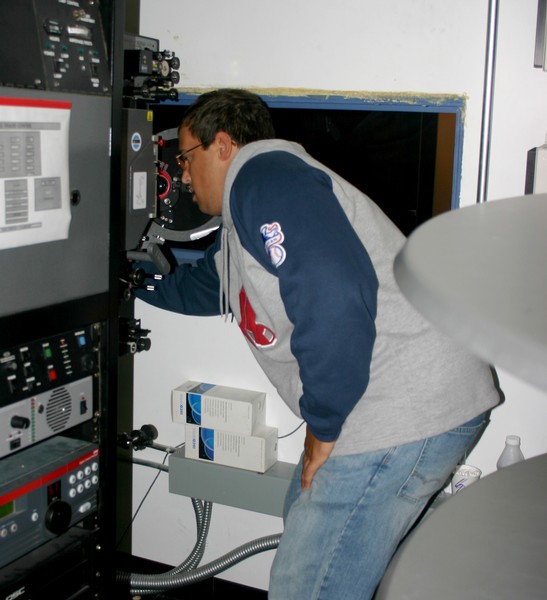How To…Project Film
September 21, 2006
While you’re enjoying your $2 movie, do you ever wonder how film gets to the silver screen? Of course not. Why would you? That’s where we come in. We embarked on our quest for knowledge to the Paramount 7 in Indianola to find out how the film is projected on to the big screen. With the assistance of Projectionist David Carroll, our questions were soon answered.
When a film comes to a theater, it comes in many small reels. Then a projectionist cuts and splices the reels together and winds the newly made film onto a giant silver platter. After the film becomes one, we begin our endeavor.
When we first saw the projector, all we saw were gears and knobs. The metallic-gray colored projector tops out at about six feet tall and four feet wide. The first step in threading the projector is moving the inside ring to a different platter and replacing it with the brain. The brain is a black colored instrument pacing the payout speed of the film. Once the brain is threaded, the film travels through different spools on an instrument called the tree.
The tree is made of many different — but important — mechanisms. It contains the platter, spools and the dancer, which controls the overall speed of the movie by “dancing” a few inches up and down the tree. Once the film leaves the tree, it travels through spools to the projector.
When film reaches the projector, it wraps around more spools until it meets a circular object called the sound drum. The sound drum reads the sound track located on the side of the film with an infrared light. It is crucial to always have the purple colored soundtrack facing you at all times.
After the film leaves the sound drum and travels through more spools it meets the shutter, which displays 24 frames per second on to the screen with a bright lamp. The tricky part of threading is lining up a frame exactly with the hole the intense light travels. After framing, the film travels through a sprocket, which helps with the movement of the film. It’s important to line up the film with the teeth on the sprocket. If they aren’t lined, up the film won’t move, and it could get scratched or possibly burned.
The film now travels to more spools until it loops around another sound drum. Once the film travels around the sound drum, it encounters more spools and one more sprocket. After the sprocket, there is a device the film must travel through to maintain the quality of the film. After the device, the film travels to the tree once again through more spools. After the spools, it meets up with the inside ring we moved at the very beginning of the process. Once everything is checked again, you touch a green button and your $2 movie lights up for your scrutiny.
Our quest came to a halt. The intricate layout of a projector was too much to handle. We both prefer to enjoy the movies, not thread them. After reading this article and trying to decipher through all of the spools and instruments, we can both testify that it’s not as easy as expected.












